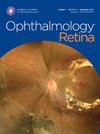The Discrepancy Between Visual Acuity Decline and Foveal Involvement in Geographic Atrophy
IF 4.4
Q1 OPHTHALMOLOGY
引用次数: 0
Abstract
Purpose
To investigate the discrepancy between visual acuity (VA) decline and foveal involvement in geographic atrophy (GA) secondary to nonexudative age-related macular degeneration (AMD), and to explore how early retinal changes impact the progression of visual impairment.
Design
Retrospective, longitudinal cohort study.
Subjects
This study evaluated 80 eyes from 60 patients (mean age, 74.2 ± 10 years) with progressing non-neovascular AMD.
Methods
Blue-light fundus autofluorescence (FAF) and spectral-domain OCT (SD-OCT) were utilized to monitor GA progression and the onset of foveal involvement. The study analyzed VA changes over an average follow-up of 60 ± 26.4 months, encompassing 785 observations. Mixed-effects models with natural splines assessed the effects of demographic and ocular characteristics on baseline VA and its rate of decline. Survival analyses compared the timing of anatomic changes with the most rapid functional declines, indicated by the highest first derivative of VA trajectories. Discrepancies between visual and anatomic changes were explored using generalized linear mixed-effects models.
Main Outcome Measures
Monthly VA changes, onset and impact of foveal involvement, and factors influencing baseline VA and rate of decline.
Results
Visual acuity declined consistently by an average of 0.010 logarithm of the minimum angle of resolution (LogMAR) per month (standard error [SE], 0.0003; P < 0.001). The onset of foveal involvement significantly exacerbated this decline, adding an average loss of 0.15 LogMAR (SE, 0.02; P < 0.001). Stabilization of VA typically occurred around 41 months post-foveal involvement. Significant factors associated with worse baseline VA were older age, female gender, unifocal GA morphology, and drusen-associated forms of GA (P < 0.05). The most rapid declines in VA typically occurred about 9 months (interquartile range, 0–27 months) before detectable subfoveal changes. The reticular FAF pattern (27/46 [59%] vs. 2/13 [15%], P = 0.02) and smaller baseline GA lesions (P = 0.01) were associated with faster deterioration preceding visible foveal damage.
Conclusions
This study demonstrates that significant VA loss in GA can precede detectable foveal involvement, suggesting a window for early interventions to slow the progression of visual impairment. Identifying specific GA characteristics and FAF patterns as predictors of rapid VA decline supports the need for personalized treatment strategies to optimize outcomes for patients with nonexudative AMD.
Financial Disclosure(s)
Proprietary or commercial disclosure may be found in the Footnotes and Disclosures at the end of this article.
地理萎缩患者视力下降与眼窝受累之间的差异
目的:研究继发于非渗出性老年性黄斑变性(AMD)的地理萎缩(GA)中视力(VA)下降与眼窝受累之间的差异,并探讨早期视网膜变化如何影响视力损伤的进展:设计:回顾性纵向队列研究:本研究使用蓝光眼底自发荧光(FAF)和光谱域光学相干断层扫描(SD-OCT)对 60 名进展期非新生血管性黄斑变性患者(平均年龄为 74.2±10 岁)的 80 只眼睛进行了评估。该研究监测了眼窝受累的起始时间,并分析了平均随访 60±26.4 个月的视力变化,共观察了 785 次。采用自然样条的混合效应模型评估了人口统计学和眼部特征对基线视力及其下降率的影响。生存分析比较了解剖变化的时间与功能下降最快的时间,功能下降最快的时间是视力下降轨迹的最高一阶导数。使用广义线性混合效应模型探讨了视觉和解剖变化之间的差异:结果:视力持续下降,平均每月下降 0.010 LogMAR(SE:0.0003,p):这项研究表明,GA 患者视力的显著下降可能发生在可检测到的眼窝受累之前,这为早期干预以减缓视力损伤的进展提供了机会。将特定的GA特征和FAF模式确定为视力快速下降的预测因素,支持了对个性化治疗策略的需求,以优化非渗出性AMD患者的预后。
本文章由计算机程序翻译,如有差异,请以英文原文为准。
求助全文
约1分钟内获得全文
求助全文

 求助内容:
求助内容: 应助结果提醒方式:
应助结果提醒方式:


